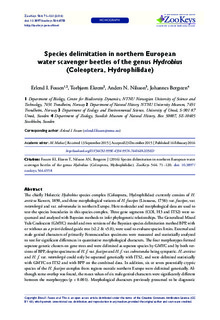| dc.contributor.author | Fossen, Erlend Ignacio | |
| dc.contributor.author | Ekrem, Torbjørn | |
| dc.contributor.author | Nilsson, Anders N. | |
| dc.contributor.author | Bergsten, Johannes | |
| dc.date.accessioned | 2016-02-17T16:15:25Z | |
| dc.date.accessioned | 2016-04-25T10:49:03Z | |
| dc.date.available | 2016-02-17T16:15:25Z | |
| dc.date.available | 2016-04-25T10:49:03Z | |
| dc.date.issued | 2016 | |
| dc.identifier.citation | Zookeys 2016, 564:71-120 | nb_NO |
| dc.identifier.issn | 1313-2970 | |
| dc.identifier.uri | http://hdl.handle.net/11250/2387132 | |
| dc.description.abstract | The chiefly Holarctic Hydrobius species complex (Coleoptera, Hydrophilidae) currently consists of H. arcticus Kuwert, 1890, and three morphological variants of H. fuscipes (Linnaeus, 1758): var. fuscipes, var. rottenbergii and var. subrotundus in northern Europe. Here molecular and morphological data are used to test the species boundaries in this species complex. Three gene segments (COI, H3 and ITS2) were sequenced and analyzed with Bayesian methods to infer phylogenetic relationships. The Generalized Mixed Yule Coalescent (GMYC) model and two versions of the Bayesian species delimitation method BPP, with or without an a priori defined guide tree (v2.2 & v3.0), were used to evaluate species limits. External and male genital characters of primarily Fennoscandian specimens were measured and statistically analyzed to test for significant differences in quantitative morphological characters. The four morphotypes formed separate genetic clusters on gene trees and were delimited as separate species by GMYC and by both versions of BPP, despite specimens of H. f. var. fuscipes and H. f. var. subrotundus being sympatric. H. arcticus and H. f. var. rottenbergii could only be separated genetically with ITS2, and were delimited statistically with GMYC on ITS2 and with BPP on the combined data. In addition, six or seven potentially cryptic species of the H. fuscipes complex from regions outside northern Europe were delimited genetically. Although some overlap was found, the mean values of six male genital characters were significantly different between the morphotypes (p < 0.001). Morphological characters previously presumed to be diagnostic were less reliable to separate H. f. var. fuscipes from H. f. var. subrotundus, but characters in the literature for H. arcticus and H. f. var. rottenbergii were diagnostic. Overall, morphological and molecular evidence strongly suggest that H. arcticus and the three morphological variants of H. fuscipes are separate species and Hydrobius rottenbergii Gerhardt, 1872, stat. n. and Hydrobius subrotundus Stephens, 1829, stat. n. are elevated to valid species. An identification key to northern European species of Hydrobius is provided. | nb_NO |
| dc.language.iso | eng | nb_NO |
| dc.publisher | Pensoft Publishers | nb_NO |
| dc.rights.uri | http://creativecommons.org/licenses/by/4.0/ | |
| dc.subject | GMYC, species complex, BPP, guide tree, Fennoscandia, morphometrics, Bayesian, genitalia, molecular phylogeny, species boundaries, morphology, cryptic species, integrative taxonomy, DNA barcoding, identification key, taxonomy, checklist | nb_NO |
| dc.title | Species delimitation in northern European water scavenger beetles of the genus Hydrobius (Coleoptera, Hydrophilidae) | nb_NO |
| dc.type | Journal article | nb_NO |
| dc.type | Peer reviewed | nb_NO |
| dc.date.updated | 2016-02-17T16:15:25Z | |
| dc.source.pagenumber | 71-120 | nb_NO |
| dc.source.volume | 564 | nb_NO |
| dc.source.journal | ZooKeys | nb_NO |
| dc.identifier.doi | 10.3897/zookeys.564.6558 | |
| dc.identifier.cristin | 1337029 | |
| dc.description.localcode | This is an open access article distributed under the terms of the Creative Commons Attribution License (CC BY 4.0), which permits unrestricted use, distribution, and reproduction in any medium, provided the original author and source are credited. | nb_NO |

